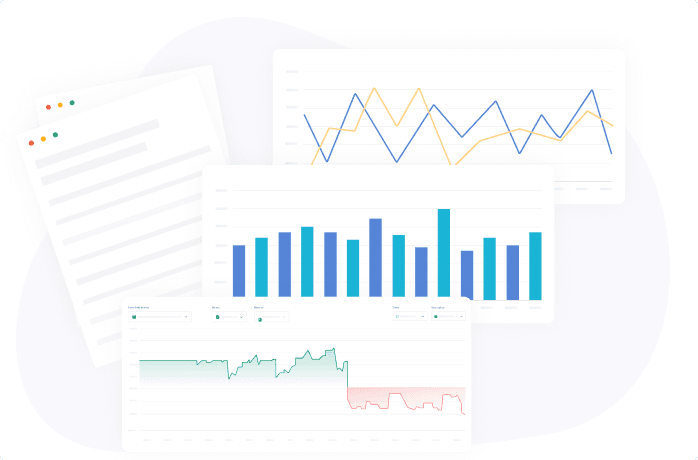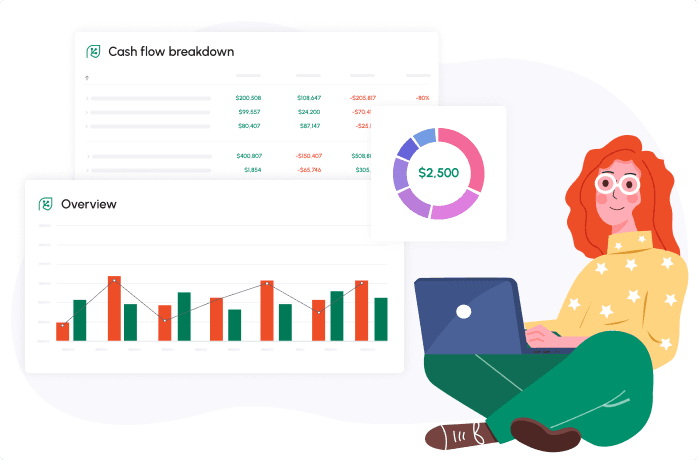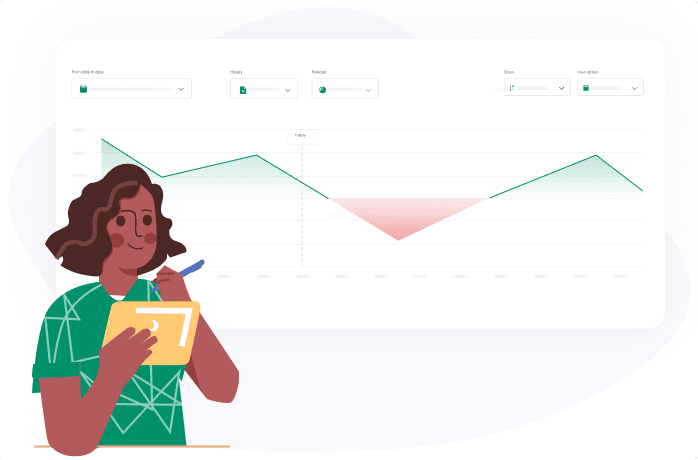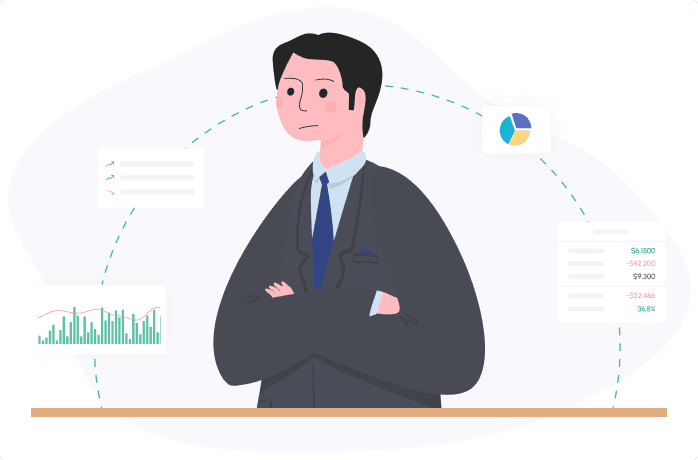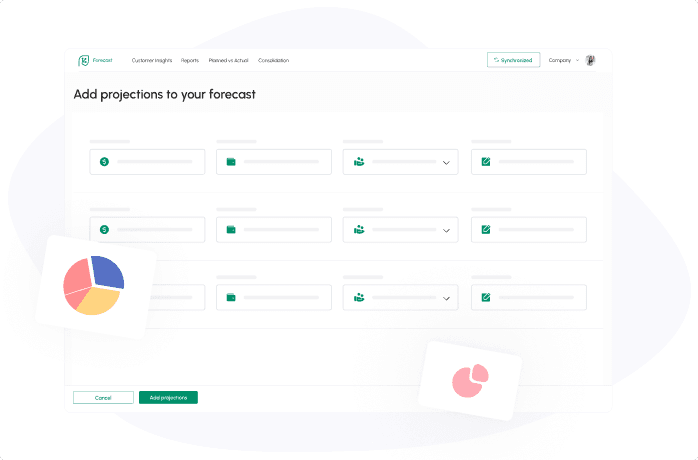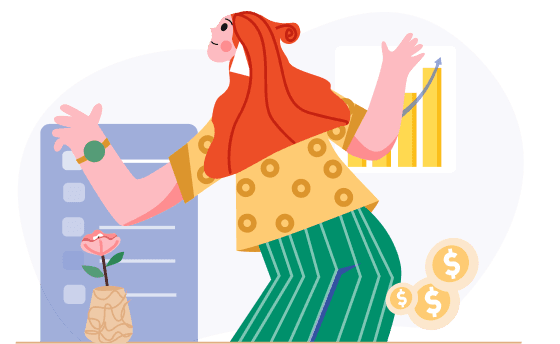

What if you could predict your business’s future with remarkable accuracy through the use of a cash flow forecast? Imagine you could know exactly when you’ll receive cash and when it will go out. This could help you steer your company through lean times or growth opportunities with total confidence.
More than just numbers on a spreadsheet, the uses of a cash flow forecast include a financial map and guiding strategic decisions. Whether you’re running a scrappy startup or scaling an enterprise, understanding the advantages of a cash flow forecast isn’t just smart, but essential for growth, stability, and peace of mind.
Simple Explanation of Cash Flow Forecasting
Successful businesses know when to invest, expand, or tighten their belts. They also know how to forecast cash flow, which involves predicting the flow of money in and out of the business for a period.
One of the benefits of a cash flow forecast is that it will help you understand your business's future liquidity.
The forecast takes the guesswork out of decision-making and helps you act with certainty. With every critical detail laid out, a cash flow forecast reveals exactly how cash will move, giving you the information you need to guide your business through both smooth and stormy times.
What Does a Business Cash Flow Forecast Include?
It tracks two main components:
Cash Inflows
- Customer payments
- Loan proceeds
- Tax refunds
- Investment returns
Cash Outflows
- Payroll
- Rent and utilities
- Supplier invoices
- Debt repayments
A Quick Cash Forecast Example
The following is a good example of what cash flow forecasting is. You are currently working as a freelance UX designer in this scenario. The $8,000 invoiced during April will be spent on building fund expenditures for $5,000, including rent payments, operational costs, and marketing expenses.
The forecast indicates you will receive $3,000 of discretionary cash which allows you to recruit support or establish financial reserve. The act of strategic decision making gets its power from forecasting tools. Using this technique enables businesses to make decisions for maintaining financial stability.
During business operations without cash flow forecasting it becomes comparable to driving without any visibility. Your financial planning obtains GPS functionality through forecasting.
 Image: Pexels
Image: Pexels
How It Helps Businesses Stay Financially Healthy
Let’s be honest—running a business without realizing the importance of a cash flow forecast is like driving blindfolded. Forecasting acts like a GPS for your finances. Consider these benefits of a cash flow forecast:
- Avoid surprises. You will know where you will have a cash shortfall, before it can cause damage..
- Time expenses wisely. Align outflows with inflows so you’re not caught short.
- Plan for taxes and payroll. You won’t have to scramble at the last minute any longer, or deal with late fees.
- Stay investor-ready. Confidently communicate financial stability and growth projections.
- Build safety nets. Put aside funds for emergencies or off-seasons.
And this isn’t just theory. According to recent data, 61% of business failures in 2024 stemmed from poor cash management, not a lack of profit.
Why is Cash Flow Forecasting Important?
Let’s dive deeper into the importance of cash flow forecast practices. While you need to know when your bills are due, this will also help you unlock smarter strategy.
Avoid Running Out of Money
Yes, even profitable businesses can go broke. How? Simple: they run out of cash before the next invoice gets paid.
Real Scenario: A creative agency is owed $50,000 by clients. But payroll and rent, totaling $40,000, are due this week. Without that incoming cash, they’re stuck.
Fixes:
- Request deposits or advance payments.
- Use milestone billing for long projects.
- Establish a line of credit while you’re cash-healthy.
Plan for Business Growth
Scaling doesn’t mean spending blindly. A business cash flow forecast helps you grow strategically, not chaotically.
How It Helps:
- Gauge how much cash growth will actually require.
- Time expansion or hiring with your revenue flow.
- Secure better vendor terms with reliable projections.
Example: A retail startup projected a 30% holiday bump. By forecasting early, they hired part-time staff and boosted inventory, resulting in record sales with zero cash hiccups.
Types of Cash Flow Forecasts
There are different methods of cash forecasting depending on your business needs. Let’s break down the most common types:
Short-Term Forecast (For the Next Few Weeks or Months)
Ideal for day-to-day decisions, this forecast covers upcoming expenses and ensures there’s enough cash on hand to meet immediate obligations.
Benefits:
- Avoids overdrafts and late fees
- Helps prioritize spending
- Reacts quickly to customer delays
Use Case: A marketing firm runs weekly cash flow forecasts. When a $6,000 client payment got delayed, they paused a software upgrade to maintain payroll.
Long-Term Forecast (For a Year or More)
This strategic approach helps businesses align goals with funding needs over time. It’s perfect for planning investments, launches, or restructuring.
Benefits:
- Guides major hiring decisions
- Informs capital investments
- Prepares for seasonal fluctuations
Long-term forecasting lays the groundwork for growth that doesn’t compromise stability.
Tools & Software for Cash Flow Forecasting
We need to talk about your tools: how to forecast cash flow efficiently depends on what you’re using to do so.
Should You Use Excel or Special Software?
Excel:
- Great for customization
- Ideal for startups or solo entrepreneurs
- Can be error-prone and time-consuming
Dedicated Tools:
- Built for collaboration and automation
- Pull data from accounting systems in real-time
- Offer dashboards, alerts, and scenario modeling
Methods of Cash Forecasting for Small Businesses
Cash Flow Frog
- User-friendly visuals
- Drag-and-drop forecasts
- Integrates with QuickBooks, Stripe, Xero
Float
- Syncs with spreadsheets
- Built for budgeting comfort
Xero
- Budget overlays
- Robust for longer-term forecasting
QuickBooks
- Embedded forecasting tools
- Simple to use for existing users
Advantage: Using tools tailored to forecasting reduces manual work and increases accuracy — a win-win for time and peace of mind.
Common Cash Flow Problems & How to Fix Them
Every business hits bumps. The secret? Fix them fast, and forecast your way around them next time.
Not Enough Money to Pay Bills
Causes: Revenue dip, unexpected expenses, seasonal lull
Fixes:
- Cut or pause underused subscriptions
- Renegotiate with suppliers
- Shift fixed costs to variable where possible (e.g., freelancers)
Late Payments from Clients
Fixes:
- Send auto-reminders and follow-ups
- Offer small discounts for early payment
- Tighten payment terms (e.g., Net 10 or 15 instead of Net 30)
Unexpected Expenses
Think lawsuits, equipment failure, or supplier issues.
Fixes:
- Keep 5–10% of monthly costs in reserve
- Regularly run “what-if” scenarios
- Secure a backup credit line
Examples of Cash Flow Forecasting in Real Business
Forecasting works in the real world—here’s proof:
- Bakery Franchise: Hired temp staff for the holidays based on projected sales, increasing revenue by 25%
- SaaS Platform: Spotted a $60K gap months ahead, secured funding just in time
- E-commerce Brand: Used forecasts to renegotiate shipping contracts, saving 18%
- Freelance Studio: Compared in-house vs outsourced work — saved $10K annually with freelancers
These wins weren’t lucky. They were forecast.
Future Trends in Cash Flow Forecasting
The next chapter of forecasting is tech-powered and team-centric. Here’s where we’re headed:
- AI-powered predictions: Learn patterns from past data to forecast smarter
- API integrations: Instantly link sales, ops, and finance
- Real-time dashboards: See issues before they escalate
- Collaborative forecasting: Get input from all departments in one unified model
According to Deloitte, 56% of small businesses plan to adopt AI forecasting by 2026. That’s not just a stat, it’s a sign that financial strategy is getting a high-tech upgrade.
Our Solutions for Cash Flow Forecasting
At Cash Flow Frog, we offer you these advantages of a cash flow forecast that will make a real difference in your business:
- Seamless integration with accounting tools
- Scenario builders with drag-and-drop ease
- Real-time dashboards for leadership teams
- CRM and ERP compatibility for enterprise users
Success Story: A retail client improved their overdraft position by 40% in just two months using our weekly forecast feature.
Why just survive when you can thrive with clear, confident cash visibility?
Final Thoughts
Know your cash. Protect your future. Forecast with clarity.
A comprehensive business cash flow forecast can help you find opportunity in financial uncertainty.. Whether you’re solving problems, planning growth, or presenting to investors, forecasting helps you lead with confidence.
For more guides, tools, and tips, visit the Cash Flow Frog Blog. Your future self will thank you.
FAQ
Related posts:
You may be interested:
New:



